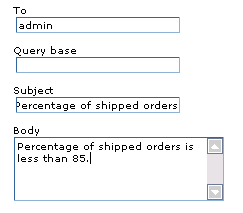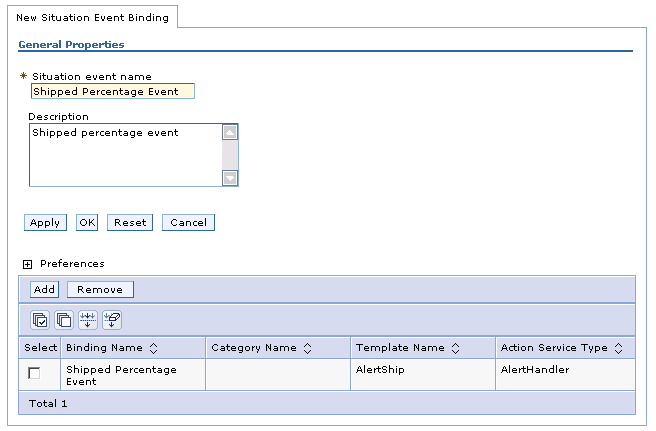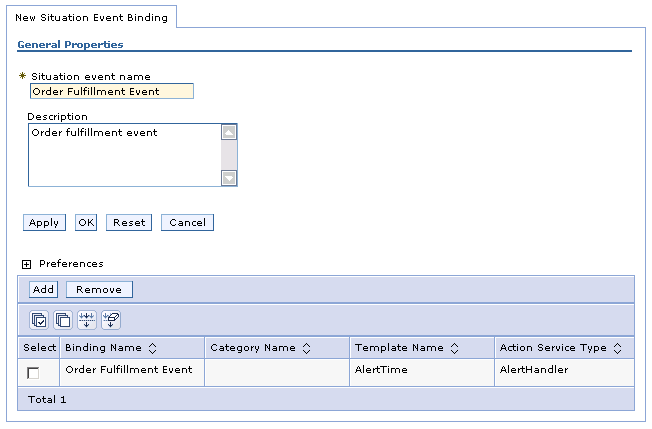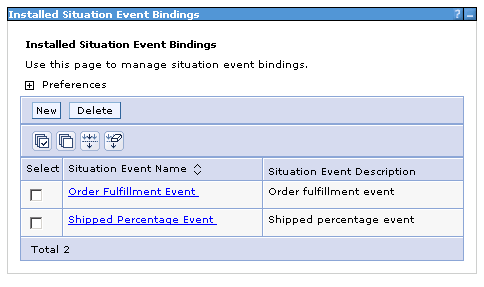Next configure WebSphere® Business Monitor’s Action Services to create alerts when business situation events are received. The situation events are sent from the monitor model as outbound events. The alerts will be visible in the Alert view on your dashboard. You do not need an LDAP server to test the situation events as was necessary in previous releases.
- Add an alert template for when the percentage of shipped orders
needs attention.
- In the administrative console, select Applications > Monitor Action Services > Template Definitions > Notifications and click New.
- For the template name, enter AlertShip, and then enter any description.
- Select Dashboard Alert. This indicates that the an alert (defined below) will be sent to the business dashboard’s alert view.
- Select User id.
- For the To field, enter admin. This user ID is the user logged into the business dashboard that will receive the alert. You must log into the business dashboard with this user ID.
- For Subject, enter Percentage
of shipped orders. This will be the title of the alert in the dashboard.
Enter the Body as Percentage of shipped orders is less than 85. Click OK.

- Add an alert template for when order processing time needs attention.
- In the administrative console, select Applications > Monitor Action Services > Template Definitions > Notifications and click New.
- For the template name, enter AlertTime, and then enter any description.
- Select Dashboard Alert. This indicates that the an alert (defined below) will be sent to the business dashboard’s alert view.
- Select User id.
- For the To field, enter admin. This user ID is the user logged into the business dashboard that will receive the alert. You must log into the business dashboard with this user ID.
- For Subject, enter Order processing time.
- For the Body enter The average
order processing time is %OrderDuration% days.
%OrderDuration% is a substitution variable in the alert. In the alert that will be sent, the situation event’s Extended Data Element, OrderDuration, will be substituted for %OrderDuration% in the body of the alert.
- Click OK.
- Now add the binding from the situation event to the action type
of the alert template for shipped percentage situations.
- In the administrative console, select Applications > Monitor Action Services > Installed Situation Event Bindings and click New.
- Enter the situation event name that you defined in the model.
You named the business situation event Shipped Percentage Event. The name
must match the value in the BusinessSituationName field in the outbound event.
You might want to copy the name from the monitor model to ensure an exact
match (do not include the quotation marks). The following screen capture from
the monitor model shows the Shipped Percentage Event attributes:

- Enter any description and then click Apply.
- In the table under Preferences, click Add.
- Enter a binding name, for example Shipped Percentage Event, and then select the template AlertShip.
- Click OK. Notice that you now have one
action defined for this situation event. If you had other action templates
defined, then you could add more actions to this event and you could send
a notification for this situation event to multiple destinations using e-mail,
alerts, and Web services.

- Click OK.
- Add the binding from the situation event to the alert template
for the action type for order processing time situations:
- In the administrative console, select Applications > Monitor Action Services > Installed Situation Event Bindings and click New.
- Enter the situation event name that you defined in the model. You named the business situation Order Fulfillment Event. The name must match the value in the BusinessSituationName field in the outbound event. You might want to copy the name from the monitor model (without the quotation marks).
- Enter any description and then click Apply.
- In the table under Preferences, click Add.
- Enter a binding name such as Order Fulfillment Event,
select the template AlertTime, and then click OK.

- Click OK again.
- In the administrative console, select Applications > Monitor Action Services > Installed Situation
Event Bindings. You will see the two bindings that
you created.
